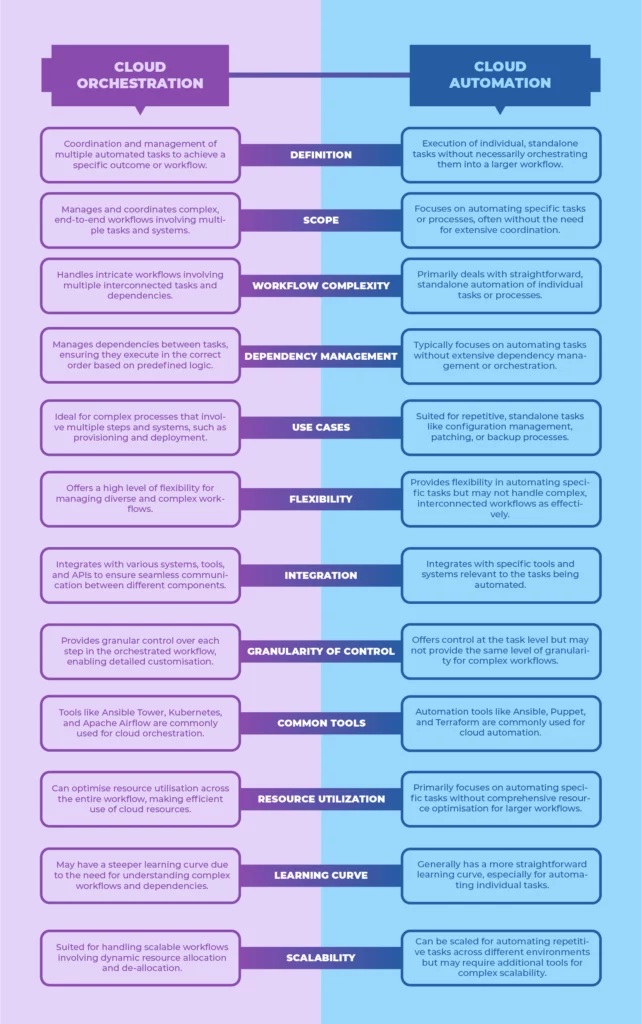Cloud orchestration is the systematic coordination and automation of various tools, applications, APIs (Application Programming Interfaces), and infrastructure within a cloud computing environment. It involves the end-to-end automation of tasks required to manage and deploy workloads seamlessly on both private and public clouds.
In simpler terms, cloud orchestration streamlines complex processes by automating the deployment, scaling, and management of resources in the cloud. This ensures efficient and optimised utilisation of cloud infrastructure, allowing organisations to respond dynamically to changing demands.
What is Cloud Orchestration?
Cloud orchestration is the process of automating and coordinating various tasks, tools, applications, and infrastructure within a cloud computing environment. It involves the seamless integration and management of diverse components to streamline workflows and optimise resource utilisation. The key aspects of cloud orchestration include:
Also read – CloudStack vs. OpenStack: A Showdown for Simplicity and Speed
Automation: Automating tasks and processes to enhance efficiency and reduce manual intervention.
Coordination: Coordinating different elements within the cloud infrastructure for a harmonised and integrated workflow.
Deployment: Automating the deployment of applications, services, and workloads on both private and public clouds.
Resource Management: Efficiently managing cloud resources, ensuring optimal utilisation and scalability.
Cloud orchestration enables organisations to achieve agility, scalability, and operational excellence by orchestrating complex processes, facilitating quicker response to changing demands, and supporting the delivery of resources through self-service models.
What is Cloud Orchestration vs Cloud Automation?

| Feature | Cloud Orchestration | Cloud Automation |
|---|---|---|
| Definition | Coordination and management of multiple automated tasks to achieve a specific outcome or workflow. | Execution of individual, standalone tasks without necessarily orchestrating them into a larger workflow. |
| Scope | Manages and coordinates complex, end-to-end workflows involving multiple tasks and systems. | Focuses on automating specific tasks or processes, often without the need for extensive coordination. |
| Workflow Complexity | Handles intricate workflows involving multiple interconnected tasks and dependencies. | Primarily deals with straightforward, standalone automation of individual tasks or processes. |
| Dependency Management | Manages dependencies between tasks, ensuring they execute in the correct order based on predefined logic. | Typically focuses on automating tasks without extensive dependency management or orchestration. |
| Use Cases | Ideal for complex processes that involve multiple steps and systems, such as provisioning and deployment. | Suited for repetitive, standalone tasks like configuration management, patching, or backup processes. |
| Flexibility | Offers a high level of flexibility for managing diverse and complex workflows. | Provides flexibility in automating specific tasks but may not handle complex, interconnected workflows as effectively. |
| Integration | Integrates with various systems, tools, and APIs to ensure seamless communication between different components. | Integrates with specific tools and systems relevant to the tasks being automated. |
| Granularity of Control | Provides granular control over each step in the orchestrated workflow, enabling detailed customisation. | Offers control at the task level but may not provide the same level of granularity for complex workflows. |
| Common Tools | Tools like Ansible Tower, Kubernetes, and Apache Airflow are commonly used for cloud orchestration. | Automation tools like Ansible, Puppet, and Terraform are commonly used for cloud automation. |
| Resource Utilization | Can optimise resource utilisation across the entire workflow, making efficient use of cloud resources. | Primarily focuses on automating specific tasks without comprehensive resource optimisation for larger workflows. |
| Learning Curve | May have a steeper learning curve due to the need for understanding complex workflows and dependencies. | Generally has a more straightforward learning curve, especially for automating individual tasks. |
| Scalability | Suited for handling scalable workflows involving dynamic resource allocation and de-allocation. | Can be scaled for automating repetitive tasks across different environments but may require additional tools for complex scalability. |
Why It is important?
Cloud orchestration is crucial in modern cloud computing environments for several reasons:
Workflow Automation: Cloud orchestration enables the automation of complex workflows that involve multiple tasks, services, and systems. This automation streamlines processes, reduces manual intervention, and ensures consistent and error-free execution.
Efficient Resource Utilisation: With orchestration, organisations can optimise the allocation and utilisation of cloud resources. Workflows can be dynamically adjusted based on demand, leading to better efficiency in resource utilisation and cost savings.
Scalability: Cloud orchestration facilitates the scalability of applications and services. It allows for the dynamic provisioning and de-provisioning of resources based on workload fluctuations, ensuring that applications can scale up or down as needed.
Also read – Creating a Cloud Exit Strategy: A Guide to Cloud Repatriation
Cross-Platform Integration: In complex IT environments, applications often span multiple platforms and services. Cloud orchestration provides a means to integrate and manage these diverse components, ensuring seamless communication and collaboration.
Faster Deployment: Orchestration accelerates the deployment of applications and services by automating the provisioning of infrastructure, configurations, and software. This speed is crucial in today’s fast-paced business environment.
Consistency and Compliance: Orchestration ensures consistency in the deployment and management of resources. This consistency is essential for compliance with regulatory requirements and internal policies, reducing the risk of configuration drift.
Enhanced Collaboration: With orchestration, different teams within an organisation can collaborate more effectively. By defining workflows and processes in a standardised manner, teams can work cohesively and contribute to the overall success of projects.
Improved Reliability: Automation through orchestration reduces the likelihood of human errors. By standardising processes and ensuring repeatability, orchestration enhances the reliability of deployments and operations.
Cost Optimisation: Efficient resource utilisation, scalability, and automation lead to cost savings. Cloud orchestration helps organisations optimise their cloud spending by ensuring that resources are provisioned and de-provisioned based on actual demand.
Adaptability to Change: In a rapidly evolving technological landscape, the ability to adapt to change is crucial. Cloud orchestration provides the flexibility to modify workflows, integrate new technologies, and respond quickly to changing business requirements.
What are Cloud Orchestration Models?
Cloud orchestration involves coordinating and automating the deployment, management, and scaling of cloud services and resources. There are various models in cloud orchestration that cater to different organisational needs:
Single Cloud Model: In this model, orchestration focuses on managing resources within a single cloud environment. It streamlines tasks and automates processes, enhancing efficiency within a specific cloud infrastructure.
Multi-Cloud Model: This model extends orchestration capabilities across multiple cloud platforms. It enables organisations to seamlessly integrate and manage resources across diverse cloud environments, promoting flexibility and avoiding vendor lock-in.
Also Read – VMware Exodus: 5 Reasons Why Apache CloudStack is the Superior Cloud Management Choice
These models play a crucial role in optimising cloud operations, allowing businesses to tailor their orchestration strategies based on the complexity and diversity of their cloud infrastructure. Whether operating within a single cloud environment or embracing a multi-cloud approach, organisations leverage cloud orchestration models to streamline workflows, enhance automation, and achieve a more agile and responsive IT infrastructure.
How to Choose the Right Cloud Orchestration Platform?
Selecting the optimal cloud orchestration platform is paramount for efficient cloud management and resource optimization. To make an informed decision, a comprehensive evaluation process is essential.
Understanding Your Organizational Needs
Before embarking on platform selection, clearly define your organization’s specific requirements:
- Workload Characteristics: Identify the types of applications and their computational demands (e.g., stateless, stateful, batch, real-time).
- Cloud Environment: Determine the preferred cloud providers (AWS, Azure, GCP, or hybrid) and any existing infrastructure.
- Scalability: Assess the anticipated growth in workload and resource needs.
- Automation Requirements: Define the level of automation desired, including infrastructure as code, CI/CD pipelines, and self-service capabilities.
- Security and Compliance: Identify critical security and compliance standards that the platform must adhere to.
- Budget Constraints: Establish a clear budget for the orchestration platform and associated costs.
Key Features and Considerations
When evaluating potential platforms, focus on these core features:
- Ease of Use: A user-friendly interface and intuitive workflow enhance adoption and productivity.
- Automation Capabilities: Robust automation features for infrastructure provisioning, configuration management, and application deployment.
- Integration: Seamless integration with existing tools, cloud providers, and monitoring systems.
- Security and Compliance: Strong security measures, including role-based access control, encryption, and compliance certifications.
- Scalability and Performance: Ability to handle increasing workloads and optimize resource utilization.
- Cost Management: Features for monitoring cloud spending, rightsizing resources, and identifying cost optimization opportunities.
- Community and Support: A strong community and responsive support channels are essential for troubleshooting and knowledge sharing.
Selecting the right cloud orchestration platform requires a careful evaluation of your specific needs and priorities. Consider conducting proof-of-concept projects to assess different platforms in your environment. Additionally, factor in vendor lock-in, long-term support, and pricing models when making your decision.
By following these guidelines and conducting thorough research, you can select a cloud orchestration platform that empowers your organization to achieve its cloud computing goals efficiently and effectively.
Apiculus Cloud Orchestration: Unleashing the Best in Cloud Management
The Apiculus Cloud Orchestration model stands out as a premier choice for cloud management, especially in environments powered by Apache CloudStack. Renowned for its flexibility and robust orchestration platform, Apiculus provides end-to-end cloud management capabilities. Its distinct advantage lies in offering a fully self-service cloud management platform for customers, coupled with a holistic approach to cloud orchestration.
One of the key strengths of Apiculus is its focus on Infrastructure as Code (IaC), a cutting-edge approach that ensures faster speed and consistency in cloud operations. By eliminating manual processes, Apiculus’s IaC brings efficiency to the forefront, enabling organisations to deploy resources rapidly and maintain consistency in their cloud environments.
Also Read – Navigating Data Localization Laws: Key Considerations for Global Enterprises
Moreover, Apiculus addresses the evolving needs of cloud strategies by introducing new services. These services, rooted in Infrastructure as Code, contribute to faster deployment, reduced errors, and enhanced security. The model excels in enhancing cost governance through automated metering, ensuring optimised resource efficiency.
In essence, Apiculus emerges as a frontrunner in the cloud orchestration landscape, empowering businesses with the tools and features necessary for efficient, secure, and cost-effective cloud management.

Kshitish is a ‘startup expert’ and has been involved with early stage startups, seeing various phases of growth, for more than 15 years. A specialist in Product Management, User Experience, Technology and Product Growth/Strategy, Kshitish is a seasoned entrepreneur with deep expertise in building enterprise products and horizontal/vertical SaaS. Kshitish did his PG in Product Design from NID, Ahmedabad.

